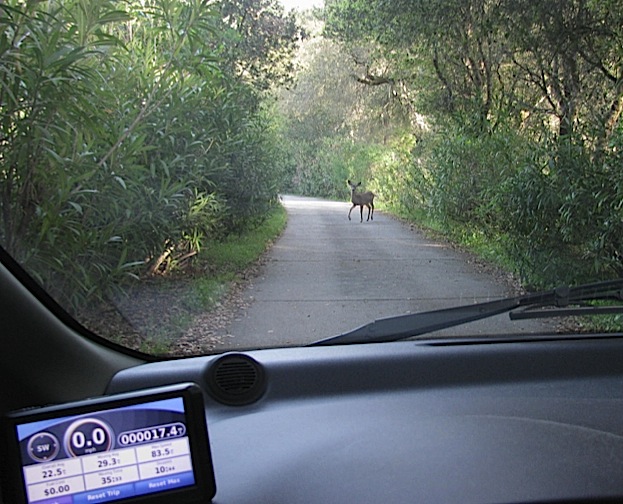bradleydavidgood777 said:
Cool! I've often thought that N was a good option for downhill. Doesn't make sense to me to brake even if recharging.
It depends on the circumstances. If you need to go slower than the grade allows for than coasting in N then you should definitely be in a drive mode. I use D for two reasons. I get to use brake lights easily and often, to help keep the drivers behind me out of trouble. It’s right next to N making changing back and forth super easy.
Can you tell us more about your style?
When it comes to “style” the most important thing is to be steady on the accelerator.
Also, the further the throttle (or regen brake) input is from the current motor speed the less power efficient the transition is.
For example: lets say you are on the Freeway and want to pass from behind a car going 50 mph and a speed limit of 65 mph. If you do so by going deep into the throttle until 65mph is reached. You waste power to motor heating and less efficient battery discharge. If you use a graduated throttle increase (as short as three seconds to increase throttle evenly) it will waste far less power. Most of the “style” habits as I think of them require awareness of upcoming changes and hazards. And an ongoing plan for lane changes etc. Proactive of, not reactive to traffic, etc. Basically, good defensive driving practices.
You say accelerate briskly, so where is your needle during that?
I have found that there is not enough difference between a 2C acceleration and a 3C acceleration to ever use 3C acceleration (except in an “emergency” type situation). 3C acceleration especially at low speeds wastes a lot of power to battery and inverter/motor system inefficiency. That’s the great thing about the iMiev one can move with traffic, or more briskly than traffic off the line easily without going above 2C. So accelerating briskly the needle is between the first mark and the second. When exiting the freeway or approaching a red light I brake very lightly and long so it’s all Regen. After a bit of practice I found it easy to tell where friction braking begins in the brake pedal throw. Avoid it, as best possible. N can be used around town in fewer circumstances but after a while you see opportunities that arise. The car coasts so well in N that on flat ground at low speed (35 mph or so), slowing is gradual enough to not irritate traffic behind me
In what circumstances do you switch to N? Like how long would the hill need to be to be worth the switch?
Anytime that I can coast without exceeding the speed limit by more than 5 mph or without slowing quickly enough to be awkward for those following behind me. If I wouldn’t be in N for more than say 4 seconds, I won’t bother. When I first got canion I did an experiment on a flat road with two stop signs in 4 miles. Did three repetitions in each direction sticking to the 25 mph speed limit on the D call the way runs. on the N comparison runs I accelerated gently to 27 then coasted in N down to 23 mph repeated over and over for the route. Using neutral in this low speed controlled experiment was 6% more efficient averaged over the three (six trips total) runs. I don’t figure it is useful or reasonable in that situation to go to all that trouble for 6%, but interesting that it did work out more efficient to do all the shifting.
When you are on the highway where is your needle and what is your speed?
There isn’t much in the way of flat freeway around here. When climbing to the canyon or climbing through it (speed limit 65mph) the needle will be between the first and second mark on the gauge. Likely averaging halfway between (~1.5C). this can be reduced to more like 1C by drafting near the speed limit. On the way back going down hill maintaining speed in a drive mode it is in the green zone at 17 to 21 amps out of the battery. Shifting to Neutral on long stretches of this freeway decent it goes to zero while speed is maintained or almost maintained. I use drafting quite a bit for the best numbers on the freeway. Always staying 2 seconds back, a Semi truck, RV, Van or large SUV are all good candidates. Drafting on the downhill return leg requires a periodic shift into D to maintain a safe following distance. Since the drafting, reducing aero drag combined with the grade results in a slow build up of speed in N
And anything else you can think of.....
The most important tip is don’t let that Amp needle jump around all over the place it should move slowly and methodically. On a hiking trip drive I average 3.2 to 3.5 mi/kWh (depending on drafting and prevailing winds etc.) when climbing climbing climbing to the trailhead. With lots of coasting and some regen coming back to the valley, that leg of the trip will range between 10.8 and 11.2 mi/kWh. As seen in other parts of the forum. Quantitative analysis shows that only about 25% to 30 % the power used to climb to altitude is returned to the battery by regen. Some of that of course is lost to aero and rolling resistance both directions but still, it is what it is.
IMO B mode is for the most efficient "jack rabbit" driving. "Jack rabbit" driving is by definition inefficient. Nice of Mitsu to account for it as best possible.
Thanks
You're welcome, hope it helps with your long trek. Practice is king!
Aerowhatt
























